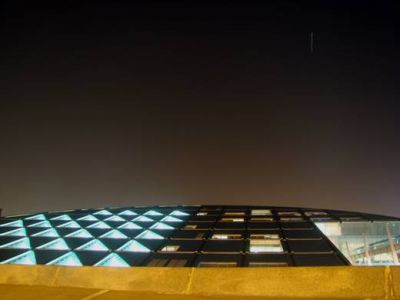20 November 2008

The International Space Station over the BA
The ISS is visible as a short streak of light in the upper right. The image was taken on 14 April 2008. The ISS was visible as a drifting star-like object, therefore it appears as a streak of light in this long exposure photo.
Photo by Aymen Ibrahem, BA Senior Astronomy Specialist
On 20 November 1998, construction of the International Space Station (ISS), the largest spacecraft ever flown into space, began with the launch of the Russian-built, US-funded Zarya module. The launch was the beginning of a complex, sophisticated international space project .
The ISS is a collaboration among NASA, the Russian Federal Space Agency, Canadian Space Agency, Japan Aerospace Exploration Agency (JAXA) and 11 members of the European Space Agency (ESA): Belgium, Denmark, France, Germany, Italy, the Netherlands, Norway, Spain, Sweden, Switzerland and the United Kingdom. More than 100,000 people are involved in this venture.
"The station's capability and sheer size today are truly amazing," said ISS Program Manager Mike Suffredini. "The tremendous technological achievement in orbit is matched only by the cooperation and perseverance of its partners on the ground. We have overcome differences in language, geography and engineering philosophies to succeed."
In December 1998, only a few weeks after the launch of the Zarya module, NASA’s space shuttle placed into orbit the US Unity connector module. Unity and Zarya were joined in space to begin the orbiting outpost's assembly, symbolizing peaceful international cooperation.
Currently, the ISS's mass is over 627,000 pounds, and its interior volume has expanded to more than 25,000 cubic feet. Since the launch of Zarya, the first command, control and power module, there have been 29 additional construction flights to the ISS: 27 aboard the space shuttle and two additional Russian missions.
One hundred sixty seven spacemen representing 15 countries have visited the orbiting complex. Crews have eaten some 19,000 meals aboard the ISS, since the first crew arrived at the station in 2000. Through the course of 114 spacewalks and robotic construction in space, the station's truss structure has grown to 291 feet long so far. Its solar arrays now have an area of 28,800 square feet, equivalent to six basketball courts. On 20 November 2008, the space station completed 57,309 orbits of the Earth, corresponding to a linear distance of approximately 2,292 million km.
"With the International Space Station, we have learned so many things -- and we're going to take that knowledge and apply it to flying to the Moon and Mars," said Expedition 18 Commander Mike Fincke, now aboard the station. "Everything we're learning so close to home, only 240 miles away from the planet, we can apply to the Moon 240,000 miles away."
Interestingly, on 20 November 2008, the ISS flew over Alexandria, Egypt. Observing from the BA Plaza, BA Senior Astronomy Specialist Aymen Ibrahem took images of the ISS while it was gracefully gliding over the Library.
To take a virtual tour of the ISS and learn more about the current mission, please visit the following link:
http://www.nasa.gov/station
Aymen Mohamed Ibrahem
Senior Astronomy Specialist